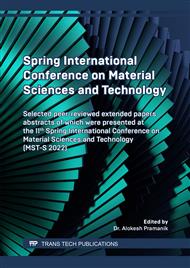p.3
p.9
p.15
p.21
p.27
p.39
p.47
p.53
Study on Clove Oil Microcapsule with Montmorillonite /Polyurethane Hybrid Wall
Abstract:
The microcapsules with inorganic/organic composites as capsule wall were prepared to optimize the performance of microcapsules. The MMT stabilized Pickering emulsion was used as template in the interfacial polymerization. TDI and EDA were polymerized at the oil-water interface to form MMT/PU composite as the capsule wall to encapsulate clove oil. Under the process condition of the dosage ratio of clove oil to TDI 5:1, the content of MMT 2%, and the reaction temperature 70 °C, the embedding rate of microcapsule could reach 92.31%. The average volume diameter of microcapsules was 49.4 μm. The microcapsules were regular and basically spherical shape, smooth surface and high elasticity. TGA showed that the thermal stability of essential oil was improved. The retention rates of clove oil in microcapsules after 40 days storage at 4 °C and 25 °C were more than 80%, indicating that clove oil microcapsules were relatively stable. The relative content of eugenol, the main component in clove oil decreased after storage, while the relative content of secondary components increased.
Info:
Periodical:
Pages:
15-20
Citation:
Online since:
June 2022
Authors:
Keywords:
Price:
Сopyright:
© 2022 Trans Tech Publications Ltd. All Rights Reserved
Share:
Citation:



